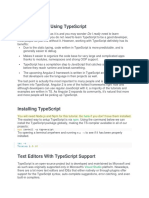0% found this document useful (0 votes)
11 views36 pagesAngular Typescript
The document provides an extensive overview of TypeScript, covering basic types, arrays, tuples, enums, and advanced concepts such as interfaces, type aliases, function types, generics, and object-oriented programming principles. It also explains the differences between var, let, and const, as well as the distinctions between assignment and equality operators. Additionally, it highlights various inbuilt functions available in TypeScript for manipulating arrays.
Uploaded by
Sarthak SumanCopyright
© © All Rights Reserved
We take content rights seriously. If you suspect this is your content, claim it here.
Available Formats
Download as DOCX, PDF, TXT or read online on Scribd
0% found this document useful (0 votes)
11 views36 pagesAngular Typescript
The document provides an extensive overview of TypeScript, covering basic types, arrays, tuples, enums, and advanced concepts such as interfaces, type aliases, function types, generics, and object-oriented programming principles. It also explains the differences between var, let, and const, as well as the distinctions between assignment and equality operators. Additionally, it highlights various inbuilt functions available in TypeScript for manipulating arrays.
Uploaded by
Sarthak SumanCopyright
© © All Rights Reserved
We take content rights seriously. If you suspect this is your content, claim it here.
Available Formats
Download as DOCX, PDF, TXT or read online on Scribd
/ 36
























































































